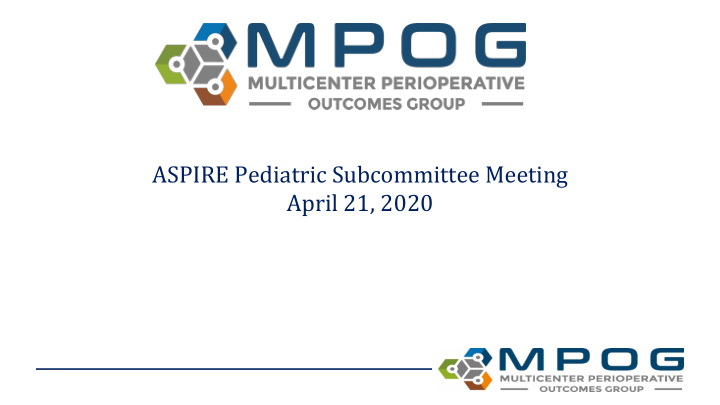



ASPIRE Pediatric Subcommittee Meeting April 21, 2020
• Upcoming Events and Announcements • December 2019 Meeting Recap Agenda • Pediatric Measure Specification Review • Temperature Management • Non-Opioid Adjunct Administration/OME
2020 Pediatric • July (Webex) Subcommittee • October at ASA (in person) Meetings • December (Webex)
• MPOG Quality Committee Meetings (web) Other 2020 April 27 th , June 22nd , August 24 th , October 26 th • MPOG Meetings • MPOG Annual Retreat October 2 nd , ASA-Washington DC
2019 Peds Subcommittee Meeting: Recap • Meeting Minutes from December 2019 have been posted to the website - Minutes - Slides • 23 Pediatric Anesthesiologists were in attendance • 2020 plans: build 2-3 pediatric specific measures - Temperature management - Postoperative respiratory complications - Add tonsillectomy and spine cases to oral morphine equivalency dashboard - Intraoperative hypotension (informational measure)
SPA Quality & Safety Measure Workgroup • Brad Taicher MD, PhD (Duke) presented an intro to MPOG at SPA Q&S meeting in February. • Proposed the formation of a metric workgroup within SPA Q&S to help inform the MPOG subcommittee of best practices in pediatric anesthesia. • First in person workgroup meeting planned for October at ASA • All members of the SPA Q&S committee are welcome to join, regardless of involvement with MPOG. Contact Meridith (Meridith@med.umich.edu) If interested in Joining.
Improved QI Dashboard – May 2020 Release
Measure Build Temperature Management
Overview of Temperature measure updates… • Focusing on hypothermia only more frequent among pediatric cases • Low median temperature value will flag cases for review – Consecutive temperature: difficult from a technical perspective. – Average temperature not utilized since it can be impacted by over-warming a patient at the end of a case. • Nadir temp < 35C will flag cases for review – Seamon et al (2012) determined that a single intraoperative temperature measurement less than 35C increased surgical site infection risk by 221% per degree below 35C (p=0.007) • Time Period: Intraoperative – Many patients are hypothermic for a significant duration of the procedure despite having a temperature > 36C postop. – Baseline temperature and the first temp value postop will be listed for each case as information only to assist in case review.
Measure Specification: Intraoperative Temperature Management - TEMP 04 (Peds) • Description: Percentage of patients < 18 years old who undergo any procedure greater than 30 minutes whom have a median core/near core body temperature < 36 o C (96.8 o F) or nadir temp < 35 o C (95 o F) • Measure Time Period: Patient in Room to Patient out of Room • Algorithm for determining Measure Start/End Times Measure Start Time – Patient In Room. If not then, – Induction End. If not then, – Procedure Start. if not then, – Anesthesia Start Measure End Time – Patient Out of Room. If not then, – Procedure End. If not then, – Anesthesia End
TEMP 04 (Peds) • Core or Near Core Temperature Monitoring Includes : – Pulmonary Artery, Distal Esophageal, Nasopharyngeal, Temporal, Tympanic, Bladder, Rectal Temperature, Axillary Temperature (arm must be at patient side) or Oral Temperature • Case Exclusions: – ASA 5 and 6 – Cases < 30 minutes duration – Unlisted Anesthesia procedure (CPT: 01999) – Organ Harvest (CPT: 01990) – Obstetric Non-Operative Procedures (CPT: 01958, 01960, 01967) – Cardiac Surgery (CPT: 00561, 00562, 00563, 00566, 00567, 00580) • Responsible Provider: Provider present for the longest duration of the case per staff role.
TEMP 04 (Peds) • Success Criteria: The median temperature intraoperatively is ≥ 36 C (96.8F ) or is the nadir ≥ 35 C (95F). • We will “clean” temperature values using the following artifact algorithm: – Less than 32.0˚C (89.6F) – Greater than 40.0˚C (104.0F) – Any minute-to-minute jumps > 0.5 ˚C equivalent. – Will account for initial warm up of probe placement • Feedback requested: In addition to baseline temp and first postop temp, what other data (if any) should be displayed as a “case detail”?
Next steps • Publish temperature management measures • Finalize specification for opioid equivalency – send to group and publish measure • Send out specifications for proposed measures
Thank you
Recommend
More recommend